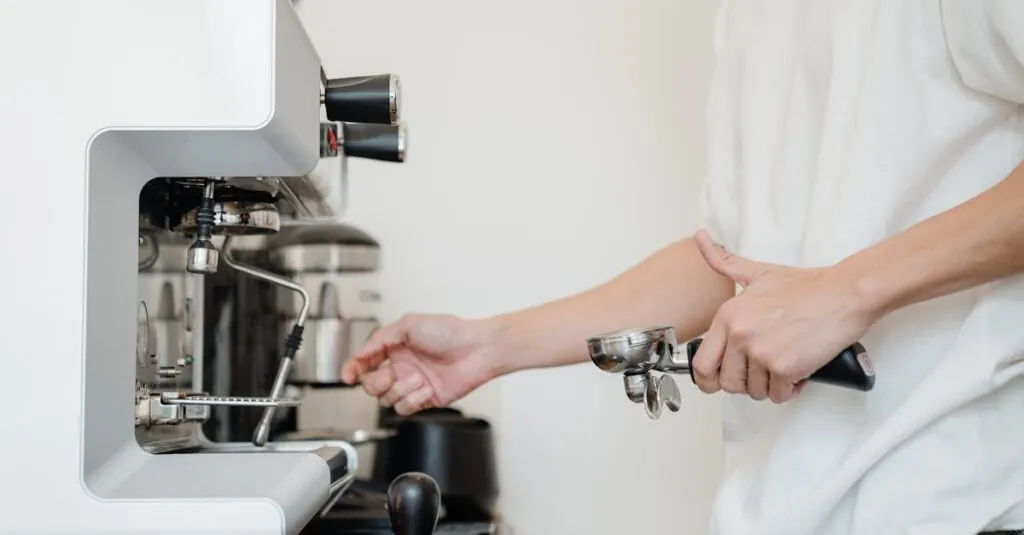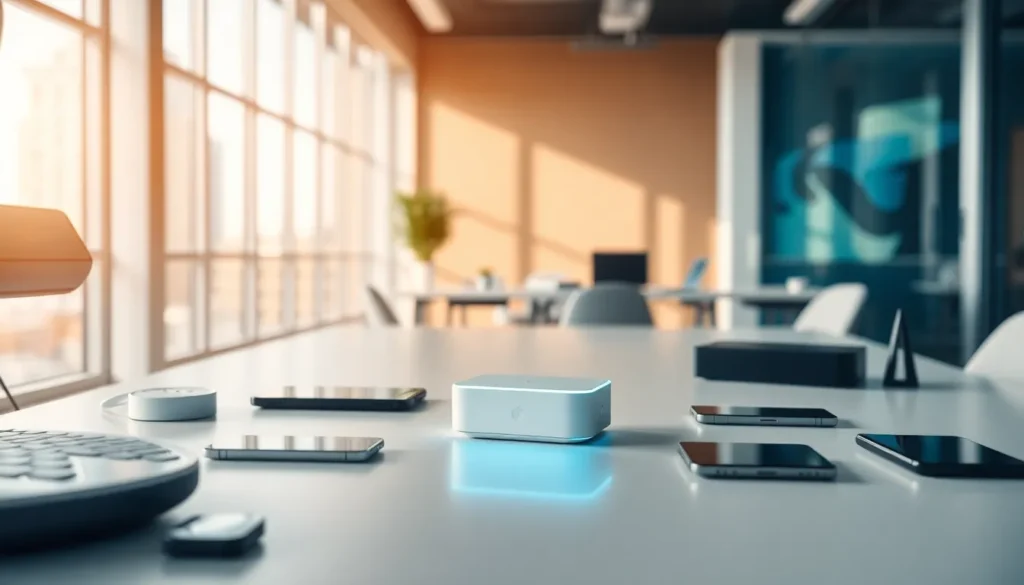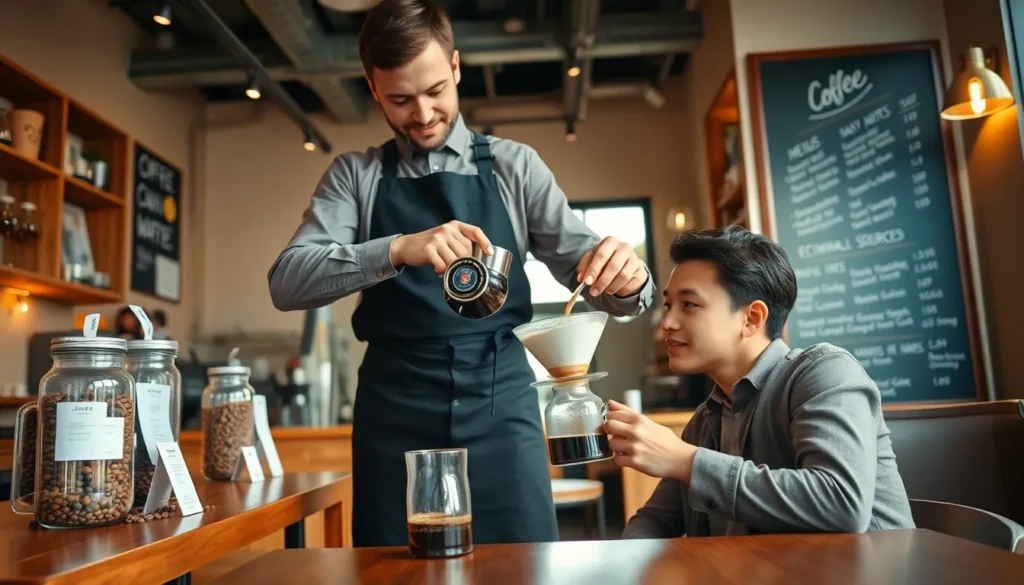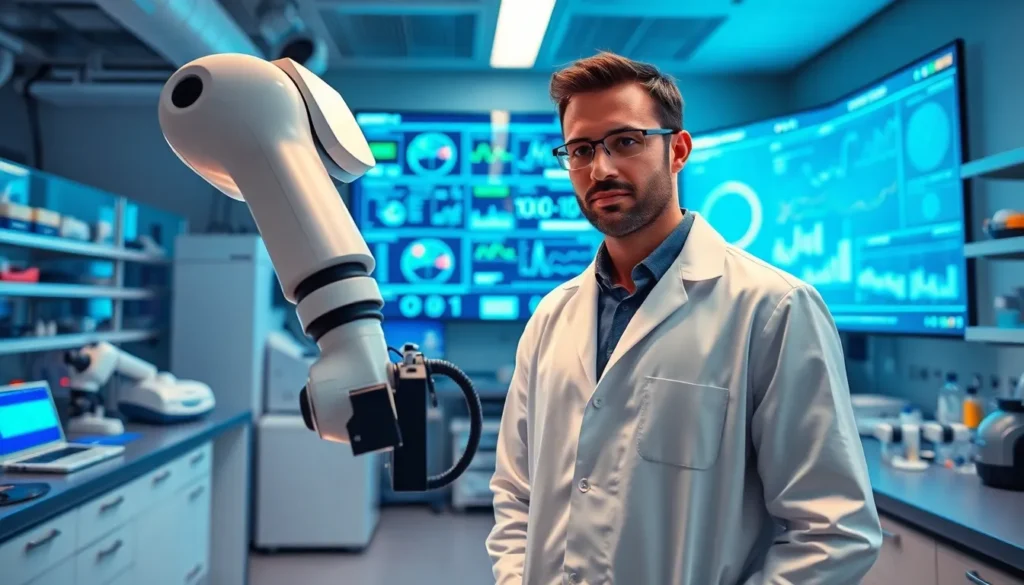Table of Contents
ToggleEspresso lovers know that the perfect shot can turn a mediocre morning into a caffeine-fueled masterpiece. But let’s face it—getting that rich, velvety goodness isn’t always a walk in the park. It’s a delicate dance of pressure, grind size, and timing. One wrong move and you might end up with a bitter brew that could wake the dead, but not in a good way.
Understanding Espresso Extraction
Espresso extraction refers to the process of brewing espresso by forcing hot water through finely-ground coffee. It involves several factors that contribute to the final taste, including grind size, water temperature, and pressure.
What Is Espresso Extraction?
Espresso extraction defines how water interacts with coffee grounds during brewing. It manages to extract flavors, oils, and compounds from the grounds. Optimal extraction results in a balanced flavor profile, showcasing sweetness, acidity, and bitterness. Aiming for 25 to 30 seconds of extraction time often yields the best results. Inadequate extraction leads to sour tastes while over-extraction creates bitterness.
Importance of Proper Extraction
Proper extraction significantly influences the taste and aroma of espresso. An even extraction permits the full spectrum of flavors to emerge. Rapid extraction causes sour notes, while slow extraction intensifies bitterness. Achieving the right balance ensures a rich, creamy body and a satisfying mouthfeel. Consistency in preparation, pressure, and temperature guarantees high-quality espresso shots every time. A solid understanding of extraction enables enthusiasts to refine their techniques effectively.
Essential Equipment for Espresso
Investing in the right equipment enhances the espresso-making process. Several key tools elevate the brewing experience and ensure a consistent flavor profile.
Espresso Machine Types
Choosing an espresso machine affects extraction quality. Two common types include manual and automatic machines. Manual machines provide full control over the brewing process, appealing to those who prefer precision. Automatic machines simplify the process with programmable features and consistent pressure. Furthermore, super-automatic machines offer convenience by handling grinding and brewing in one unit. Each type caters to different skill levels and preferences, ensuring espresso enthusiasts find a suitable fit.
Grinder Considerations
Selecting a grinder significantly influences the espresso outcome. Burr grinders produce uniform grind sizes, promoting optimal extraction. Blade grinders, while less expensive, can create inconsistent grinds, undermining flavor. Adjustability in grind settings allows for fine-tuning according to coffee bean types and freshness. Moreover, grinding just before brewing maximizes flavor retention, ensuring a fresh cup. Prioritizing quality and precision in a grinder sets the foundation for a successful espresso experience.
Key Factors Influencing Extraction
Understanding key factors is vital for achieving optimal espresso extraction. These elements collectively influence flavor, aroma, and overall quality of the brew.
Coffee Bean Selection
Choosing high-quality coffee beans significantly impacts extraction. Specialty beans sourced from established regions offer unique flavor profiles. Ideally, fresh beans should be used, as they preserve essential oils and aromas. Look for beans roasted within the last two weeks for peak freshness. Additionally, exploring different roast levels can reveal the best flavor characteristics for specific preferences.
Grind Size and Consistency
Grind size directly affects extraction time and flavor intensity. A fine grind allows for a faster extraction, while a coarser grind produces a slower extraction. Consistency in grind size is crucial; uneven grounds lead to over- or under-extraction. Utilizing a burr grinder ensures uniformity, allowing for balanced extraction. Adjusting the grind based on taste preferences enables refinement of the final espresso profile.
Dose and Tamping Techniques
Accurate dosing and proper tamping significantly influence espresso quality. Using 18 to 20 grams of coffee often yields optimal results. Consistent pressure when tamping, approximately 30 pounds, helps create an even coffee bed. An even tamp reduces channeling, promoting uniform extraction. Experimenting with slight adjustments in dose and tamping pressure allows for flavor refinement in the final shot.
Brewing Process for Optimal Extraction
Achieving optimal espresso extraction involves controlling several critical factors. Two of those factors include water temperature and pressure, as well as time and yield.
Water Temperature and Pressure
Water temperature plays a vital role in espresso extraction. Aim for a temperature between 195°F and 205°F for the best results. Outside this range, flavors may become harsh or underwhelming. Pressure also significantly impacts extraction, with the ideal pressure set at 9 bars. Consistent pressure ensures uniform extraction, promoting balanced flavors. Deviations in temperature or pressure can lead to undesirable taste attributes, so precision is essential.
Time and Yield
Timing influences the final espresso yield, typically achieved in 25 to 30 seconds. This duration permits extraction of sugars, acids, and oils, creating a complex flavor profile. Shots extracted in under 25 seconds may lack depth, while those exceeding 30 seconds can taste bitter. Aim for a yield of 1.5 to 2 ounces per shot for optimal flavor balance. Consistently monitoring time and yield contributes significantly to crafting a well-rounded espresso.
Common Espresso Extraction Issues
Espresso extraction issues can significantly impact the final beverage quality. Understanding the symptoms of under-extraction and over-extraction helps in adjusting brewing techniques effectively.
Under-Extraction Symptoms
Under-extraction often results in a sour taste. When extraction time is too short, the espresso lacks sweetness, and acidity dominates the flavor profile. A watery consistency often accompanies under-extraction. Typically, a shot pulled in less than 25 seconds experiences these issues. The crema appears thin, with little to no rich color. Adjusting the grind size to a finer setting and increasing the extraction time usually corrects these symptoms. Dosing slightly more coffee can also help achieve balanced flavors. By addressing these factors, espresso enthusiasts can create a well-rounded cup.
Over-Extraction Symptoms
Over-extraction tends to produce bitter flavors. When the brew time exceeds 30 seconds, unpleasant astringency often emerges. The mouthfeel can feel dry and chalky, detracting from the overall experience. Shots pulled too slowly typically exhibit these characteristics, leading to an unpleasant drink. A dark, oily crema may also signal over-extraction. Opting for a coarser grind size or reducing the brew time can improve the extraction process. Additionally, adjusting the coffee weight down can balance the resulting flavors. These simple tweaks can ensure a more enjoyable espresso shot.
Mastering espresso extraction is a rewarding journey for coffee lovers. By focusing on key elements like grind size, water temperature, and pressure, anyone can elevate their brewing skills. Attention to detail in each step can significantly impact the final flavor profile, allowing for a rich and balanced espresso experience.
Investing in quality equipment and fresh coffee beans is crucial for achieving consistent results. With practice and patience, espresso enthusiasts can overcome common extraction challenges and enjoy a delightful cup every time. Embracing the art of espresso will not only enhance morning routines but also deepen appreciation for this beloved beverage.




